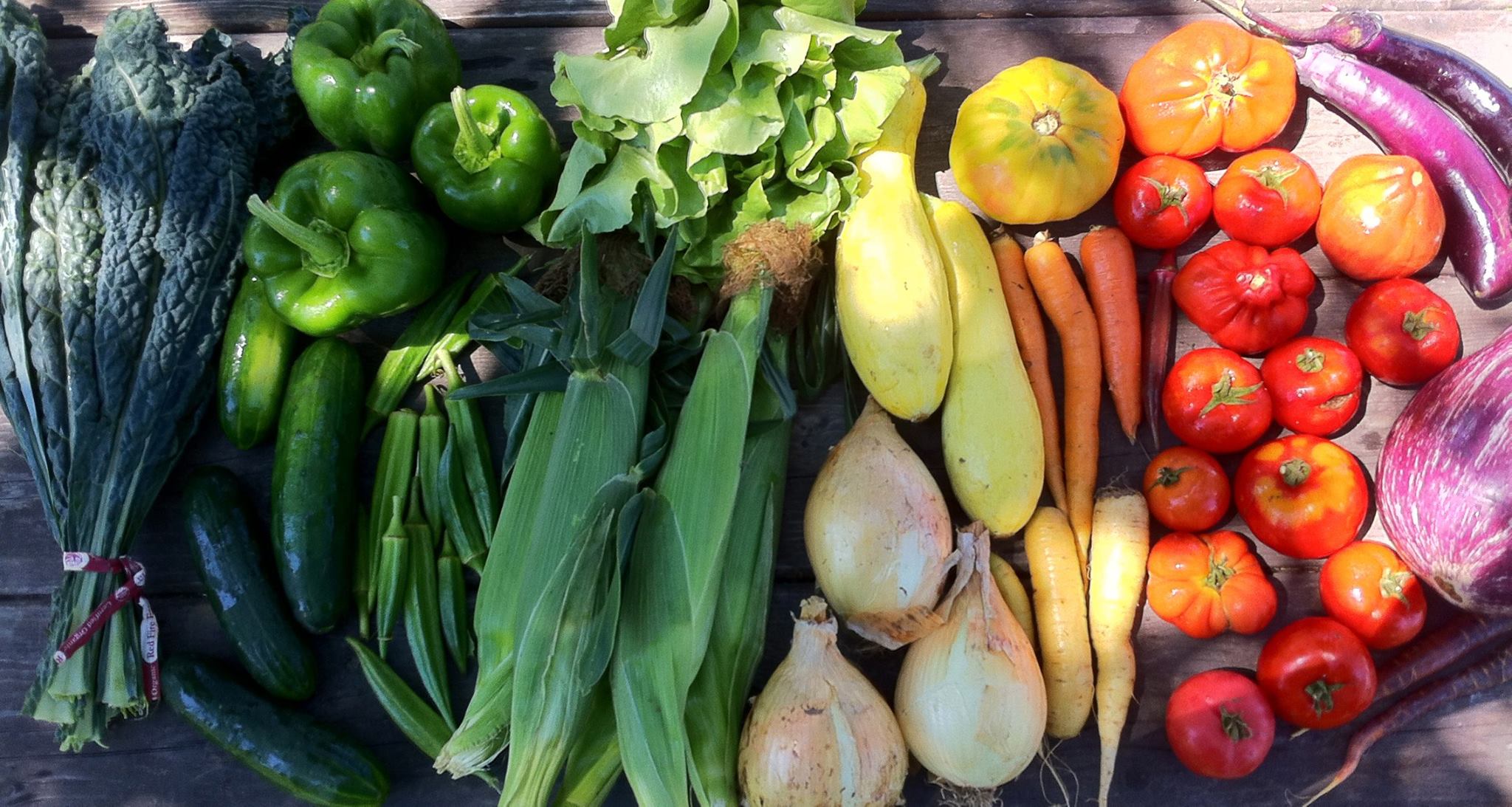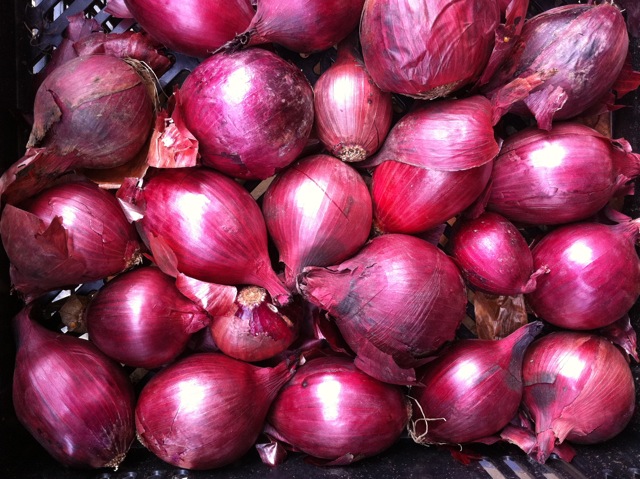
Spinach
The Basics
Spinach is one of the healthiest greens out there. Super nutrient-dense, spinach can be eaten raw in salads or cooked. Spinach is related to Swiss chard, beets, and the grain quinoa.
Cooking Tips
Try spinach in a simple salad, or lightly braised or sauteed with garlic as a side or part of a main dish.
For picky eaters, spinach can easily be incorporated into a wide variety of dishes: chop it finely and add to pasta sauce, meatloaf or meatballs, lentils, beans, or quesadillas or burritos.
You can also try a long, slow cook, and add butter and cream for a creamed spinach dish.
Spinach is an excellent green for making smoothies because of its mild flavor and tender leaves.
Storage Tips
Wrap loosely in a plastic bag in the fridge for 4-6 days. Discard any leaves that are yellowed or soft.

Shallot
The Basics
We grow two varieties of shallots, a red and a yellow type. We grow them mostly for the winter, as they store very well. Prized by chefs, shallots have a delicate onion-y flavor with a touch of garlic in it.
Cooking Tips
You can use them anywhere you would onions. They’re nice in warm dressings and sauces. They’re also great raw sliced on sandwiches.
A recipe for classic French vinaigrette often includes red wine or sherry vinegar, Dijon mustard, fresh herbs, and diced shallot.
Try slicing them thinly and frying until very crisp. Blot them on a paper towel, and then store in a glass jar. This makes an excellent topping for Asian dishes, baked potatoes, breadcrumb toppings, and dressings.
Storage Tips
Store in a cool, dark place with good ventilation. They will stay good for up to a month, but then they may begin sprouting and will taste bitter.
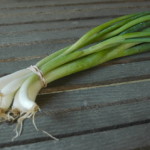
Scallion
The Basics
Scallions are in the Allium family with garlic, onions, shallots, and chives. They are also known as spring onions or green onions.
Cooking Tips
Chop off the root end and use the entire stalk for cooking. Save the roots and place them in a glass of water to re-grow the stalk.
They are great added raw to salads, thrown into sautes just at the end, or in miso soup.
Scallions are even a delicious little salad by themselves, sliced thinly length-wise and soaked in cold water until they begin to curl. Toss with Korean red pepper flakes, rice vinegar, sugar, salt, and sesame oil.
Roast whole in the oven with olive oil, and green beans, and perhaps a little balsamic vinegar.
Savory
The Basics
Summer savory and winter savory are closely related to rosemary and thyme. Savory is relatively unfamiliar, but once you begin using it, it’s hard to go back! It has a peppery flavor that adds dimensions to savory dishes, with winter savory having a more concentrated flavor than summer savory.
Cooking Tips
Both excel in an herb rub for meats and fish, in a Dijon vinaigrette, stuffing, eggs, beans, and flavored vinegar. Add sprigs when cooking beans to enrich the broth, and then more fresh chopped to the finished beans.
Savory has also be used medicinally in a tea to aid indigestion and sore throat, or the leaves can be rubbed on bug bites to bring relief from itchiness.
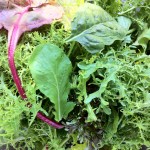
Salad Mix
The Basics
One of our spring, fall, and winter season crops is salad mix, a blend of lettuces and colorful greens. A bag of this mix holds much more nutritional value than eating a head of iceberg or even Romaine lettuce. A rule of thumb when picking out healthy salad greens is the darker the green, the more nutritional value.
Dark leafy greens in our salad mix include cress, spinach, tatsoi, ruby streaks mustard, arugula, mizuna, and a variety of lettuces. These greens are packed full of vitamins K, C, E and some B, as well as minerals including iron, calcium and potassium.
Cooking Tips
Salad greens are a great base for larger dishes. Add other seasonal vegetables to make a more filling salad, or use the greens as a bed under a fried egg for breakfast, or a portion of meat, fish or tofu.

Sage
The Basics
Sageis most common in Italian and Middle Eastern recipes. Sage also has a long and varied history of medicinal uses, including its use as an herbal tea. Sage is a perennial shrub commonly grown in herb and flower gardens, with lovely blue and purple flowers.
Cooking Tips
More typically associated with hearty, autumn harvest-type meals, sage pairs very well with winter squash, beans, onions, cheese, garlic, pork, and poultry.
Try it cooked in butter or olive oil with garlic as a topping for pasta, especially good on potato gnocchi!
Storage Tips
Store fresh leaves in a plastic bag in the fridge for 3-5 days. To freeze sage, wash, dry, and place in a bag in the freezer. To dry sage, wash the leaves and hang in a cool, dry place.
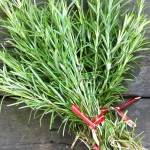
Rosemary
The Basics
This wonderfully aromatic herb comes from a perennial shrub that’s the staple of any herb garden. Hailing from the Mediterranean, rosemary is used heavily in Italian and other regional cuisines.
Cooking Tips
Rosemary goes beautifully with meats and fish, in soups and stews, and with roasted vegetables.
When dried, its flavor will mellow. Try it with potatoes, or put sprigs under the skin of a roasted chicken.
We sell our rosemary by the bunch, which you can easily rinse and hang in a dark place to dry for the winter.
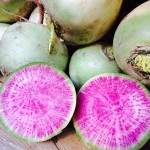
Storage Radishes
The Basics
We store watermelon and black radishes all winter to liven things up when the cold sets in. Radishes are in the Brassica family along with broccoli, cabbage, kohlrabi, cauliflower, turnips, and Brussels sprouts.
Cooking Tips
Watermelon radishes are mild and beautifully colored with pink insides, so they make beautiful edible garnishes. Slice thin whole circles to put on top of salads.
Black radishes are spicier, with a scaly black outside and creamy white interior. They’re great sliced with butter and salt on bread. Add raw spinach and herbs for a great sandwich. You can grate them raw on salad, or do a grated salad with radishes, olive oil, salt and pepper, carrots, sweet onion, raisins, apples, anything you like.
If you don’t like the bite of radishes, try sauteing them, it takes the bite off and makes them sweeter. We also like to use them on a surface such as crackers, and for dipping in hummus. These radishes are also great to pickle.
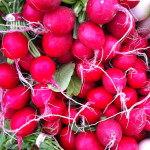
Red Radish
Cooking Tips
These bunched red radishes are our favorite to grow in summer for their balance of sweet and spicy kick. Gorgeous sliced paper thin in salads, or quarter and serve with salt and butter.
Like bunched spring turnips and bunched beets, you can also use the radish greens! Try them sauteed with butter and lemon, in soup, or in pesto.
Storage Tips
For best storage, cut the greens from the radish roots when you put them away, and keep both in a plastic bag or container.
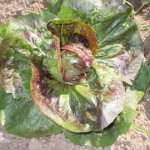
Radicchio
Cooking Tips
This bitter green has a strong flavor that pairs excellently with caramelized onion, sharp cheese, a vinaigrette, dried or fresh fruit, and sweetened nuts.
Try it raw, lightly wilted, or grilled for your next salad.
Saute the onions in olive oil until starting to caramelize, then add balsamic vinegar and radicchio. Chop the outer leaves in large pieces, then the tender inner leaves a little later. Add a little salt and agave nectar or other sweetener. Tweak the balance between bitter radicchio, balsamic, and sweet as you cook. Chop some extra-sharp cheddar and nestled it the leaves before plating your dish.




